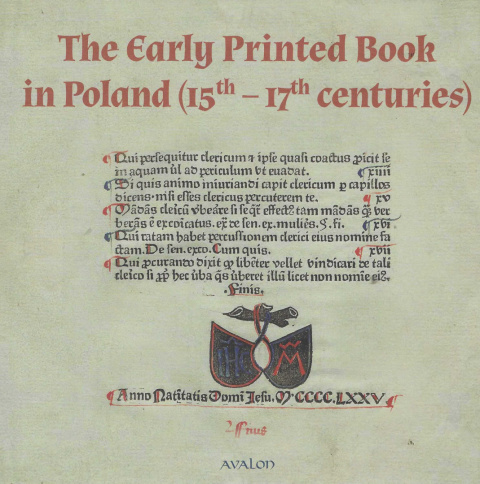-
Koszyk jest pusty
-
x

-
Koszyk jest pusty
-
x
- Kategorie
-
The Early Printed Book in Poland (15th-17th centuries)


| Wysyłka w ciągu | 24 godziny |
| Cena przesyłki | 11 |
| Dostępność |
Mała ilość
|
| Kod kreskowy | |
| ISBN | 9788377306406 |
| EAN | 9788377306406 |
| Zostaw telefon |
Autorzy: Janusz S. Gruchała, Michał Czerenkiewicz
Rok wydania: 2023
Liczba stron: 396
Okładka: twarda
Format: 21,5 cm x 20,5 cm
Uwagi - książka w języku angielskim
The first print appeared in Krakow five hundred and fifty years ago. Everywhere Gutenberg’s successors appeared, this ushered in a new era in communication and contributed to numerous changes in education and public life. This part of Europe in which Poland is located also participated in similar processes as other countries of the continent. Yet, some remarkable phenomena emerged, reliant on political and religious determinants. Print appeared at the rise of political processes resulting in the formation of nobles’ democracy, furthered religious tolerance, owing to which Poland became “a country without stakes”, and led to the birth of “the golden age” of Polish culture.
The following book presents the history of the printed book in the first two hundred years of its presence in Poland. We are convinced that this will be inspiring for each and every one of us. We cherish a hope that in times of the dusk of “the Gutenberg’s galaxy”, as predicted by many, the fact of showing old books has sense, for it brings back the legacy of the old epochs in its richness and diversity.
Pierwszy druk ukazał się w Krakowie pięćset pięćdziesiąt lat temu. Wszędzie, gdzie pojawiali się następcy Gutenberga, zapoczątkowało to nową erę w komunikacji i przyczyniło się do licznych zmian w edukacji i życiu publicznym. Ta część Europy, w której leży Polska, również uczestniczyła w podobnych procesach, jak inne kraje kontynentu. Pojawiły się jednak pewne niezwykłe zjawiska, zależne od uwarunkowań politycznych i religijnych. Druk pojawił się wraz z rozwojem procesów politycznych, których efektem było ukształtowanie się demokracji szlacheckiej, pogłębił tolerancję religijną, dzięki czemu Polska stała się „krajem bez stawek” i doprowadził do narodzin „złotego wieku” polskiej kultury.
Niniejsza książka przedstawia dzieje książki drukowanej w pierwszych dwustu latach jej obecności w Polsce. Jesteśmy przekonani, że będzie to inspirujące dla każdego z nas. Żywimy nadzieję, że w przewidywanych przez wielu czasach zmierzchu „galaktyki Gutenberga” pokazywanie starych ksiąg ma sens, gdyż przywraca dziedzictwo dawnych epok w jego bogactwie i różnorodności.
(opisy wydawcy)
Spis treści:
Introduction /5
Printing houses in European cities (major centres included) /15
Krakow - the city where Polish printing was born /17
A calendar found behind the bookcase /29
The first printing house in Krakow /37
Szwajpolt Fiol and the origins of the Cyrillic printing /45
Paper mills in Poland /53
Printing in Polish. The beginnings /61
The beginig of the 16th century - new era /69
The second half of the 16th century /89
Different languages and writing systems /105
Jewish books /117
Protestant printing /127
Cyrillic books of the 16th and 17th centuries /137
Post-Tridente Catholicism and printing /147
The human book /155
Academy and the printed book /167
Printer's device. The coming of the logo /177
Bibles /187
Liturgical books /203
Printing outside Krakow /211
Woodcut in the printed books in Krakow /221
The copperplate engravings in the printed books in Poland /237
The largest 17th century Krakow printing houses /247
Financial and legal conditions: printers, privilages and censorship /275
Commenst on the layuot of old printed books /287
A book in the monastery /299
Bookbinding in Poland /309
The royal and dignitary book collections /325
Supralibros, bookplates and other forms of indicating the ownership of a book /355
Book trade in Poland /373
Sources of illustrations /383
T
Dane producenta
Wydawnictwo Avalon
ul. Żmujdzka 6 B
31-426 Kraków
Poland
redakcja@wydawnictwoavalon.pl
